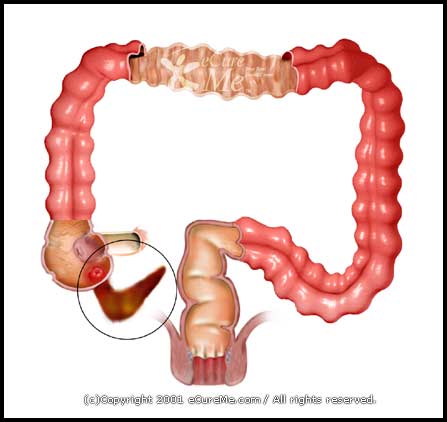 Appendicitis requires immediate medical attention so it's important to learn its symptoms — and how they differ from a run-of-the-mill stomachache — so you can seek medical care right away.
Appendicitis requires immediate medical attention so it's important to learn its symptoms — and how they differ from a run-of-the-mill stomachache — so you can seek medical care right away. The symptoms of appendicitis (which is inflammation of the appendix) start with a mild fever and pain around the bellybutton, and can be accompanied by vomiting, diarrhea, or constipation. The stomach pain usually worsens and moves to the lower right side of the belly.
Call your doctor immediately if you suspect that your child has appendicitis. The earlier it's caught, the easier and quicker it will be to treat.
About Appendicitis
The appendix is a small finger-like organ that's attached to the large intestine in the lower right side of the abdomen. The inside of the appendix forms a cul-de-sac that usually opens into the large intestine. When that opening gets blocked, the appendix swells and can easily get infected by bacteria.
If the infected appendix isn't removed, it can burst and spread bacteria and infection throughout the abdomen and lead to serious health problems.
Appendicitis mostly affects kids between the ages of 11 and 20, and is rare in infants. Most cases of appendicitis occur between October and May. A family history of appendicitis may increase a child's risk, especially in males.
Symptoms
Call the doctor immediately if your child shows symptoms of appendicitis, including:
- significant abdominal pain, especially around the bellybutton or in the lower right part of the abdomen (perhaps coming and going and then becoming consistent and sharp)
- low-grade fever
- loss of appetite
- nausea and vomiting
- diarrhea (especially small amounts, with mucus)
- frequent urination and/or an abnormally strong urge to urinate
- swollen or bloated abdomen, especially in infants
There is no way to prevent appendicitis, but with sophisticated diagnostic tests and antibiotics, most cases are identified and treated without complications.
If appendicitis goes untreated, the inflamed appendix can burst 24 to 72 hours after the symptoms begin. If the appendix has burst, the pain may spread across the whole abdomen, and the child's fever may be very high, reaching 104° Fahrenheit (40° Celsius).
The symptoms of appendicitis can vary according to a child's age. In kids 2 years old or younger, the most common symptoms are vomiting and a bloated or swollen abdomen, accompanied by pain.
If you suspect that your child has appendicitis, call your doctor immediately and don't give your child any pain medication or anything to eat or drink unless instructed to by the doctor.
Diagnosis
Because the symptoms of appendicitis can be so similar to those of other medical conditions, it's often a challenge for doctors to diagnose it.
To confirm or rule out appendicitis, a doctor will examine the abdomen for signs of pain and tenderness, orders blood and urine tests, X-rays of the abdomen and chest, and a CT scan.
If the doctor suspects appendicitis, you may be told to stop giving your child any food or liquids in order to prepare for surgery.
Treatment
Appendicitis is treated by removing the inflamed appendix through an appendectomy. Surgeons usually remove an appendix either by making a traditional incision in the abdomen or by using a small surgical device (a laparoscope) that creates a smaller opening. An appendectomy usually requires a 2- to 3-day hospital stay.
Before and after surgery, intravenous (IV) fluids and antibiotics will help keep infection at bay and decrease the risk for wound infections after surgery. If needed, your child will also receive pain medication.
If the infected appendix bursts, it must still be removed surgically, but a longer hospital stay may be needed so that antibiotics can kill any bacteria that have spread in the child's body.